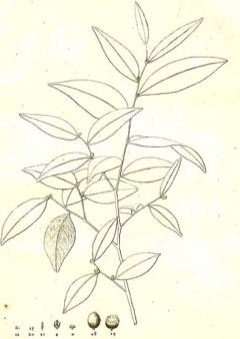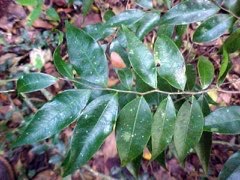 |
|
http://www.edibleplants.org |
 |
| cybertruffle.org.uk |
Translate this page:
Summary
Oxandra lanceolata, commonly known as Haya Prieta or Lancewood, is an evergreen tree about 15 m tall that is valued for its high quality wood and grown in the Caribbean. The wood is extremely strong and hard, durable, and elastic.
Physical Characteristics

 Oxandra lanceolata is an evergreen Tree growing to 10 m (32ft) by 8 m (26ft) at a medium rate.
Oxandra lanceolata is an evergreen Tree growing to 10 m (32ft) by 8 m (26ft) at a medium rate.
See above for USDA hardiness. It is hardy to UK zone 10.
Suitable for: light (sandy), medium (loamy) and heavy (clay) soils and prefers well-drained soil. Suitable pH: neutral and basic (mildly alkaline) soils and can grow in very alkaline soils.
It cannot grow in the shade. It prefers moist soil.
UK Hardiness Map
US Hardiness Map
Synonyms
Bocagea virgata (Sw.) Benth. & Hook.f. Cananga lancea Poit. ex DC. Guatteria virgata (A.Rich.) Dunal
Plant Habitats
Edible Uses
References More on Edible Uses
Medicinal Uses
Plants For A Future can not take any responsibility for any adverse effects from the use of plants. Always seek advice from a professional before using a plant medicinally.
None known
References More on Medicinal Uses
The Bookshop: Edible Plant Books
Our Latest books on Perennial Plants For Food Forests and Permaculture Gardens in paperback or digital formats.

Edible Tropical Plants
Food Forest Plants for Hotter Conditions: 250+ Plants For Tropical Food Forests & Permaculture Gardens.
More

Edible Temperate Plants
Plants for Your Food Forest: 500 Plants for Temperate Food Forests & Permaculture Gardens.
More

More Books
PFAF have eight books available in paperback and digital formats. Browse the shop for more information.
Shop Now
Other Uses
Wood
Other Uses The light yellow wood is made up entirely of sapwood. The texture is very fine; the grain straight; lustre is medium; there is no distinctive odour or taste. The wood is very strong, extremely hard, elastic; durable. It is moderately difficult to work because of its high density, but finishes smoothly and is excellent for turnery. Said to be the equal of boxwood in hardness, it is used for making fishing rods, billiard cues, archery bows, articles of turnery, masts, textile machinery, and small tool handles[316 , 448 ]
Special Uses
References More on Other Uses
Cultivation details
References Carbon Farming Information and Carbon Sequestration Information
Temperature Converter
Type a value in the Celsius field to convert the value to Fahrenheit:
Fahrenheit:
The PFAF Bookshop
Plants For A Future have a number of books available in paperback and digital form. Book titles include Edible Plants, Edible Perennials, Edible Trees,Edible Shrubs, Woodland Gardening, and Temperate Food Forest Plants. Our new book is Food Forest Plants For Hotter Conditions (Tropical and Sub-Tropical).
Shop Now
Plant Propagation
Seed -
Other Names
If available other names are mentioned here
black lancewood, lancewood, haya prieta, asta - Spanish, yaya - Spanish, Yaya, Bois de lance.
Native Range
SOUTHERN AMERICA: Cuba (Greater Antilles), Jamaica, United States (Puerto Rico)
Weed Potential
Right plant wrong place. We are currently updating this section.
Please note that a plant may be invasive in one area but may not in your area so it's worth checking.
Conservation Status
IUCN Red List of Threatened Plants Status : This taxon has not yet been assessed

Growth: S = slow M = medium F = fast. Soil: L = light (sandy) M = medium H = heavy (clay). pH: A = acid N = neutral B = basic (alkaline). Shade: F = full shade S = semi-shade N = no shade. Moisture: D = dry M = Moist We = wet Wa = water.
Now available:
Food Forest Plants for Mediterranean Conditions
350+ Perennial Plants For Mediterranean and Drier Food Forests and Permaculture Gardens.
[Paperback and eBook]
This is the third in Plants For A Future's series of plant guides for food forests tailored to
specific climate zones. Following volumes on temperate and tropical ecosystems, this book focuses
on species suited to Mediterranean conditions—regions with hot, dry summers and cool, wet winters,
often facing the added challenge of climate change.
Read More
Expert comment
Author
(Sw.) Baill.
Botanical References
Links / References
For a list of references used on this page please go here
A special thanks to Ken Fern for some of the information used on this page.
Readers comment
| Add a comment |
|
If you have important information about this plant that may help other users please add a comment or link below. Only comments or links that are felt to be directly relevant to a plant will be included. If you think a comment/link or information contained on this page is inaccurate or misleading we would welcome your feedback at [email protected]. If you have questions about a plant please use the Forum on this website as we do not have the resources to answer questions ourselves.
* Please note: the comments by website users are not necessarily those held by PFAF and may give misleading or inaccurate information.
To leave a comment please Register or login here All comments need to be approved so will not appear immediately.
|
Subject : Oxandra lanceolata
|
|
|
|